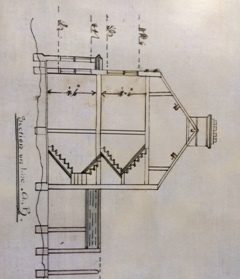Does psychological disposition create place or does place create psychology? And what are the implications of the answers for the formation of written characters? Angela Graham looks ahead to her session in Cardiff Book Festival, this Sunday 9th September, 10.45am.
Offering a few thoughts here is not to pre-empt the conversation I’ll be having with novelist, Mandy Sutter at the Festival but rather to showcase the richness of the theme. Certainly, Mandy’s wonderful book, ‘Bush Meat’ provides multiple perspectives on it. Set in Nigeria and Britain, it offers both an indigenous and an incomer perspective − in the two countries. We see the Nigerians and the British ‘at home’ and as strangers in each other’s strange land.
A place can be experienced and understood in different ways depending on the psychological perspective of the people engaging with it. I’ll focus here on some of the implications of this for writing.
Does psychological disposition create place or does place create psychology? And what are the implications of the answers for the formation of written characters?
As a means of exploring these issues briefly I’d like to offer one of the short stories in my collection, A City Burning. The protagonist in ‘An Ulster Psyche’, who comes from the ‘indigenous’ culture, is shocked to discover that sacred sites have been visited by someone from the ‘supplanting’ culture. What these places mean to the protagonist is the cumulation of thousands of years of dwelling, celebration and interpretation, and of representation in story in particular.
This ‘outsider’ has not only gone where her ilk never go but has captured the places in photographs and put them on public display. This invites people from even further ‘outside’ to react to and interpret the places, bringing their own perspectives to bear. What will this sudden invasion and exposure do to the mesh of meaning woven over generations? Will it affect the places themselves? Should it be resisted?
Situations such as this are often even more complicated than they appear on the surface. In the world of this story we’re dealing with tensions between a culture with Irish Gaelic roots and that of Scots planters sent to Ireland under Tudor and Stuart monarchs to consolidate their hold on land. There was certainly a Gaelic element among the Scots but they had largely embraced the Protestant Reformation and so, although all were Christian, major confessional differences widened the gap.
 Over time, the incomers grew strong roots and came to regard themselves as indigenous and as natural guardians of the land so there is not a simple binary pattern here, a right-and-wrong. The ‘outsider’ in the story does not perceive herself to be such and, unaware of the numinosity of the places she explores, she is not desecrating but celebrating them. In fact, it would be truer to say that she does experience their inherent numinosity but she brings almost none of the interpretative associations of the longer-established culture to bear on her reading of them.
Over time, the incomers grew strong roots and came to regard themselves as indigenous and as natural guardians of the land so there is not a simple binary pattern here, a right-and-wrong. The ‘outsider’ in the story does not perceive herself to be such and, unaware of the numinosity of the places she explores, she is not desecrating but celebrating them. In fact, it would be truer to say that she does experience their inherent numinosity but she brings almost none of the interpretative associations of the longer-established culture to bear on her reading of them.
Tenacious memories of territorial disputes preserve accounts of what land means; what its significance is; what happened where and how the outcome of events displays the righteousness, or otherwise, of protagonists. The sense of self, of a personal meaning in the universe, is bound up with land, even for those who have never owned any or who are in other respects thoroughly urban. In Ireland, whose populations experienced huge dispossessions of land through famine as well as war, one does not have to look far back for sensitivity to land lost and the yearning to recover it.
The naming and re-naming of land is very significant, but so too is the appropriation of a name and the concomitant loss or suppression of its meaning. In the story, the protagonist is aware that a place-name which, to the ‘incomer’ is only a string of syllables is, to someone able to grasp its Gaelic roots, a precise and meaningful description of actuality.
This is no surprise in Wales where place-names often have a kind of doubled existence, in Welsh and in an anglicised version. Some, such as Swansea/Abertawe, have names which demonstrate very clearly the difference of perspective in the namer: the Nordic, Sweyn’s Island and the Welsh, Mouth of the River Tawe.
The powerful emotions stirred by identification with land and place can be experienced just as strongly within a much smaller compass, that of the home. A home is more than a house but nevertheless the ‘topography’ of a house can be very influential on the personal psyche.
I recently managed to view the plans for the house in which I spent my childhood. I researched the background to the planning application, discovering who had proposed it and why. It’s a tiny, nondescript terraced house but enormously significant to me. Why? Apparently, I am following a well-established pattern.
Michael D. Higgins, the President of Ireland, considered this in a speech in July this year on The Idea of Home:
In 1958… Gaston Bachelard completed a short volume entitled The Poetics of Space… [in which] he turned his attention to what he termed the ‘phenomenology of the imagination’, the study of the poetic meaning of the house and of the intimacy imbued within everyday household places, such as the attic, the cellar or the drawers. In The Poetics of Space, he writes, ‘[the house] is our first universe, a real cosmos in every sense of the word’, that it is ‘the topography of our intimate being’.
The house, Bachelard reasoned, emerges as the home by becoming a site of intimacy and creativity, of memories and dreams.”
Bachelard’s book is wonderful. I love, for instance, his ideas about windows as eyes, the house as a seer as well as something seen and his notions on shiny surfaces!
As a writer, I instinctively wonder about the homes my characters come from. This is probably a way of accessing their deeper layers and certainly of learning how the world looks through their eyes. Sometimes it’s a question of glancing around a character’s home of origin; in other cases, a thorough inspection is required.
Recently, when looking again at Seamus Deane’s marvellous novel, Reading in the Dark, I was very struck by its outstanding opening chapter, Stairs: February 1945:
On the stairs, there was a clear, plain silence.
It was a short staircase, fourteen steps in all, covered in lino from which the original pattern had been polished away to the point where it had the look of a faint memory. Eleven steps took you to the turn of the stairs where the cathedral and the sky always hung in the window frame. Three more steps took you on to the landing, about six feet long.
‘Don’t move,’ my mother said from the landing. ‘Don’t cross that window.’
I was on the tenth step, she was on the landing. I could have touched her.
‘There’s something between us. A shadow. Don’t move.’
Standing back from my collection of short stories, I see that I am drawn to sharing with the reader precise descriptions of interiors in an attempt to give a clear line of sight on the target. I find Seamus Deane’s precision exemplary in this respect. The shadow, the presence, the faint memory – all of which burgeon as the story develops – are not only introduced with tremendous economy and a breath-stopping tension but the place itself, the stairs, and then the whole house, are used to amplify the development of character amongst the family members as they age and as their relationships become complicated by the interplay of location (stairs, house, street, town, country), circumstance and personality.
My story ‘The Road‘ is located at the foot of a flight of stairs and aims to make good imaginative use of the particular viewpoint afforded to the protagonist from that position.
Writing about place can be a compensation for not being there. Knowing otherwise banal facts about the origins − the roots − of my childhood home, for instance, helps me to integrate myself into a place from which the Northern Irish Troubles to some degree alienated me. I’m aware that I’m engaging in an act of re-integration.
Exile creates new perspectives on place even as the place itself, and the exiled person, may be changing. This situation is explored by Cardiff poet, Abeer Ameer:
E.T. Goes Home
I wonder whether E.T. struggled to conform
when he went back home
a glowing piece of him left
in the mind of Elliot
whether the chrysanthemum lived on
in the environment of a spaceship
whether the frogs
freed from their glass cages
and chloroform pillows
survived the journey
to ponds and rivers
whether they fit in
lab frogs
born and raised
whether they knew
how to hunt for worms, flies,
chill with the amphibious brethren
in and out of water
were they welcomed back
into open arms
or treated with suspicion
as aliens
out of place
wherever they go.
And, witness, that other theme of the Festival session – is that an essential ingredient of writing about place? This is a question I’m keen to explore. In my own case I have to accept that growing up identified with a ‘suspect community’ has made me more than averagely keen to have an alibi at all times, proof that I was where I claim to have been: place and time and corroborating statements. This probably arises from a sense of not being secure in a place, even at home; but also from an urge to push back against the official record with facts as I experienced them.
It is particularly interesting at the moment in Northern Ireland, especially around this year’s twentieth anniversary of the Good Friday Agreement, to see how history is being written. It’s fifty years since the start of the Troubles, plenty of time for personal experience to become the stuff of history and I am fascinated by ways in which ‘the accepted version’ emerges out of many versions of the past and becomes ‘the Truth’ even while there are plenty of us around to challenge aspects of it. I certainly feel pushed to use fiction, especially the fiction of the witnessed event, to get some important things on the factual record, to bear witness – but that’s a whole other story.












